The road to recovery for global travel is taking shape as post-pandemic life starts to resume in different parts of the world. Through a combination of digital vaccine passports, increasing airline capacity and a country-specific traffic light system of testing or quarantine restrictions, international travel is forecast to be back in the second half of 2021 and tracking at between 38% and 33% of 2019 levels.
Readying for revenge travel
Revenge-travel is top of mind for consumers as more people receive vaccines and confidence in safer travel conditions soar. Airlines and airports are hedging their bets ahead of the summer holiday season with new routes and seat capacity being added in coming weeks for key traveller destinations. Meanwhile new data are showing rising levels of consumer demand for bookings as availability starts to resume closer to pre-pandemic levels.
On Skyscanner, weekly booking volume increased by 75% between February and March 2021. According to the booking site’s latest traveller insights, 64% of users are planning a long-haul trip as their main holiday in 2021, while 35% are planning a short-haul trip.
TripAdvisor’s travel trends to watch for 2021 indicate that consumers are planning to travel overseas in the second half of the year, but they won’t wait to make plans; 47% of people surveyed by the travel booking platform are planning to travel internationally and 1 in 9 have already booked a trip. Vaccinations have the potential to be a game-changer for traveller confidence, according to the report, 77% of travellers say they will be more likely to travel internationally if they receive the vaccine.
IATA’s recent tourism outlook survey in the US points to a more confident cohort of travellers who are looking forward to travelling again as soon as possible. 57% expect to be travelling within two months of the pandemic being contained. While 72% want to travel to see family and friends as soon as they are able to book. However, 84% say they will not travel if there is a chance of having to quarantine at destination.
From a weak start to 2021, IATA projections have suggested air travel demand in 2021 will be 38% of 2019 levels in an optimistic scenario and 33% of 2019 levels should travel restrictions remain widespread.
This stance prompted recently departed IATA chief, Alexandre de Juniac to suggest personal and leisure travel will return from the second half of 2021 as borders reopen to tourists hungry for travel and to reunite with families and friends. “We will likely start seeing a change in the air travel landscape after May or June this year,” he said. “We at IATA are already working with states to design and plan protocols and road maps for the reopening of borders.”
He was talking about IATA’s Travel Pass, a digital Covid-19 status verification app which looks set to be widely used to prove a traveller’s vaccination history and Covid-19 test results for international or inter-regional travel.
After the IATA pass was cleared for use in Singapore (from 1 May), the app continues to gain momentum with a successful trial for Singapore Airlines and roll out uptake from 20 further carriers including Iberia, Etihad, Qatar Airways, Emirates and Korean Air.
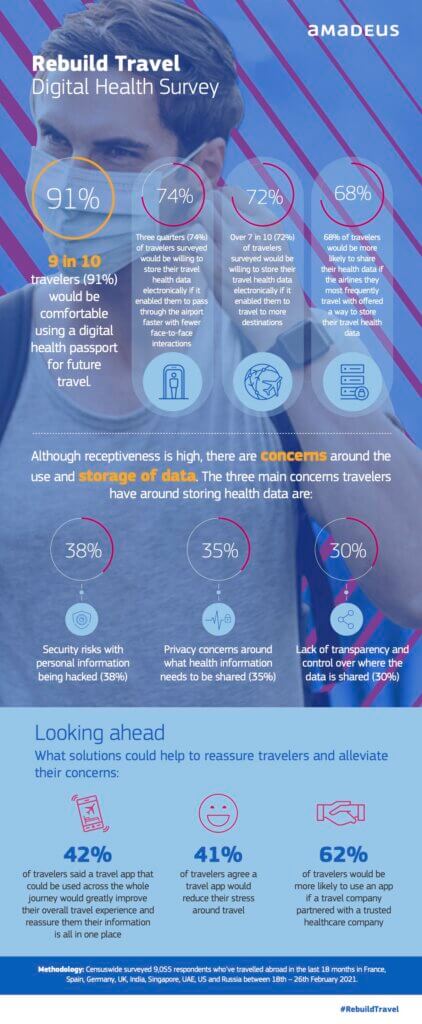
A majority (91%) of travellers are keen to use digital pass tools to facilitate a reboot of global travel, according to travel logistics firm Amadeus. It’s becoming clear that consumers will choose convenience and access to travel instead of having trust issues over data privacy – and sooner rather than later – 41% of travellers said they would book international travel within six weeks of restrictions lifting, demonstrating that the appetite to travel remains high.
Furthermore, convenience of travel seems to be a key driver for opting in to a digital health pass: just under three quarters (74%) of travellers surveyed would be willing to store their travel health data electronically if it enabled them to pass through the airport faster with fewer face-to-face interactions, dropping slightly (72%) if it enabled them to travel to more destinations; while more broadly, 42% of travellers said a travel app that could be used across the whole journey would greatly improve their overall travel experience and reassure them their information is all in one place.
Vaccine freedom
The UK and US are leading the way for a H2 2021 return to overseas travel, based on vaccines roll out and trials for digital domestic passports allowing a (slow) return to freedom of movement.
Vaccinated UK residents have been given the go-ahead to travel once borders open and based on the UK government’s Global Travel Taskforce plan. This plan takes the form of a traffic light system (green, amber, red) that means countries are rated on their proliferation of vaccine rollout and tendency to host Covid-19 variants.
International travel in and out of the UK can resume on 17 May (at the earliest), when the current ban on non-essential travel will be lifted, but this will depend on a further review of the risks, especially as a third-wave of infections is ongoing in Europe and the region is seeing much lower vaccination rates than the UK.
Depending on their destination, travellers will have to be tested before departure but arrival countries would be more lenient to vaccinated passengers. Upon returning passengers will face varying degrees of quarantine or testing, depending on the green, amber or red status of the origin country.
US travellers can travel abroad if they are fully vaccinated. The latest travel advice suggests that vaccinated passengers do not need to get tested before departure unless the destination requires it, nor do they need to quarantine upon return. However, it’s mostly inter-regional travel, such as the Caribbean or Mexico where leisure travel for US travellers is taking place. Europe is still off-limits with a few exceptions, such as Turkey or Croatia, where US citizens are permitted entry if they produce evidence of a negative Covid-19 PCR test before departure.
In Europe, the 27 member countries of the EU have endorsed the idea of a digital green pass vaccine certificate, which is expected to become widely used across the bloc. “Finally, we have a tangible solution to coordinating and harmonizing travel measures,” Eduardo Santander, chief executive of the European Travel Commission told the New York Times. “I think other countries like the US will also come up with their own technological solutions that will be compatible and after a period of trials this summer, a global standard will be established.”
Increasing airline capacity
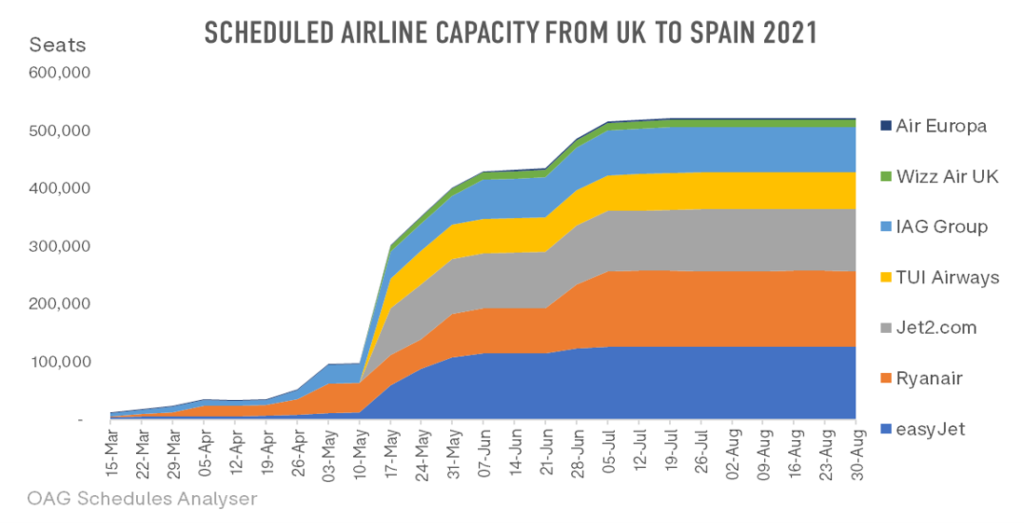
Spain is shaping up to be a bright spot for uncertain UK holiday makers. The popular tourism destination lifted entry restrictions for UK travellers from 30 March, with officials confirming the country would not have its travel ban extended because of the success of the UK vaccine rollout. According to OAG, airlines are ramping up their scheduling to Spain for an early start to the summer season, on the basis that agreement will be found to ensure much of the Spanish market can return to normal this summer.
Understandably, the date of 17 May has been earmarked by airlines as key and the current (additional) schedules show a huge ramping up of capacity from the likes of easyJet, Ryanair, Jet2.com, TUI and airlines in the IAG group (British Airways, Vueling and Iberia) all piling in.
If these airlines manage to operate the newly re-scheduled half a million seats in each direction each week through the summer, Spain’s flights capacity will almost be back to August 2019 levels: the market will have moved from just 7% of operating capacity in mid-April to 83% by July 2021.
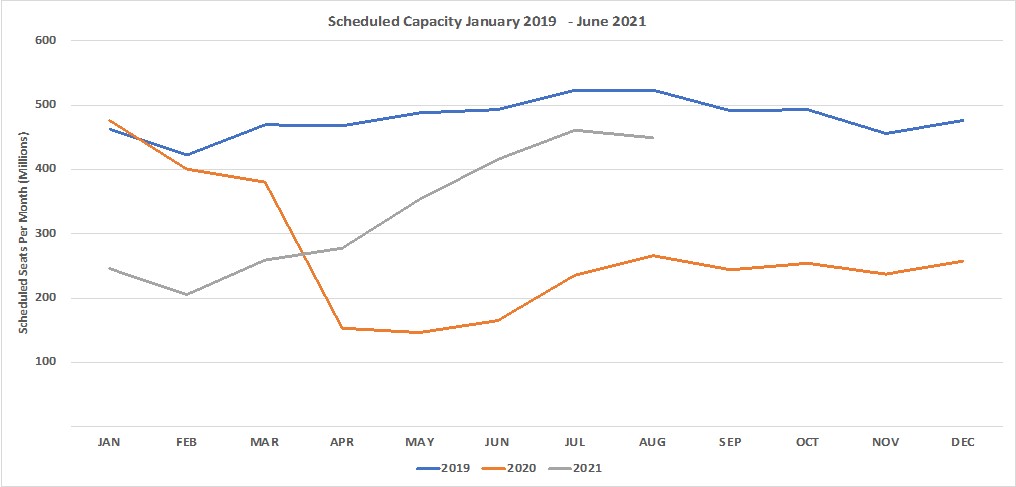
One sign that airlines are hedging their bets on an early summer season travel reboot is the upward trajectory of global capacity from a range of carriers. OAG reports that the end of March saw weekly count reach 62.1 million, which represented a 4% increase and the highest in 12 months.
“It is very early but airlines appear to remain generally bullish around the summer season with capacity trending upwards in every month of the next two quarters: certainly, airline network planners would appear to be injecting more capacity into a vaccine populated world,” says OAG.
The third wave of Covid cases in Western Europe does not appear to be having any impact on airlines adding capacity (in the last week of March) with some 930,00 additional seats or a modest 20% growth week on week. In particular there is 24% growth from Germany and 49% growth in Italy. Similarly Eastern Europe saw 16% weekly growth – reflecting optimism in the market.
In the US market, airline capacity is also increasing. There was a focus on potential Easter travel for a few airlines that added seats in time for the spring break period.
Nearly all the major US-based carriers have announced a range of new destinations and ‘hub by-pass’ services responding to the stronger leisure demand that has been a feature of the robust domestic market in recent months. OAG reports on the growth in airport pairs that will be operated with numerous new routes being added in May and June from all the carriers, especially for Florida, where most of the activity seems to be taking place.

Other regional markets with strong growth from the end of March, are South East Asia (+10%), the Southwest Pacific (+11%) and North Africa (+13%) where in each case one country market is driving those levels of growth. In total all of the capacity growth leaves us still below 60% of the pre-pandemic capacity and despite all of the capacity growth in Western Europe the region remains the weakest market with less than 30% of its normal capacity.
US focus on domestic, inter-regional travel
According to flights data specialist ForwardKeys, US travellers’ appetite for inter-regional travel is rebounding in line with travel restrictions easing and more widespread vaccinations among the adult population.
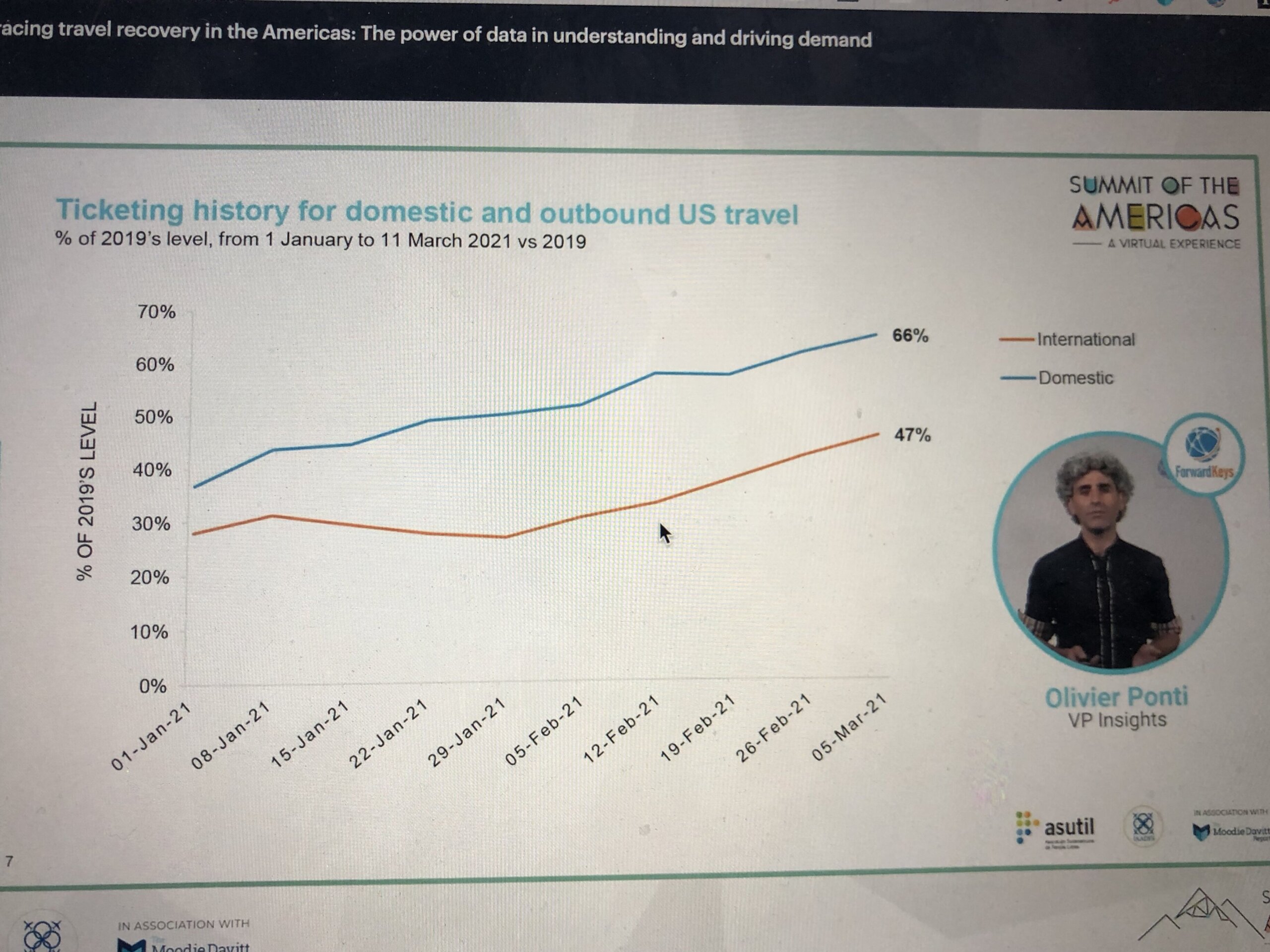
“US domestic and regional is where we can expect the highest level of tourism reactivation in the first half of 2021,” says Olivier Ponti VP of insights for the firm, speaking at the Summit of Americas virtual conference, hosted by The Moodie Davitt Report in partnership with the IAADFS and ASUTIL travel retail organisations.
US domestic travel is on a steady upwards course reaching 66% of 2019 levels, while due to the continued rise of new cases of Covid-19, Brazil is still facing a slow recovery – with travel only 27% of pre pandemic levels.
“Spring break 2021 is an important driver for future bookings,” says Ponti. “The first major national holiday of the year shows there is fresh domestic demand and last minute bookings have soared. In 2019, for a trip between March to May, 59% of travellers booked to go to the Dominican Republic at least two months in advance and in 2021, 59% booked less than two months before their departure date.”
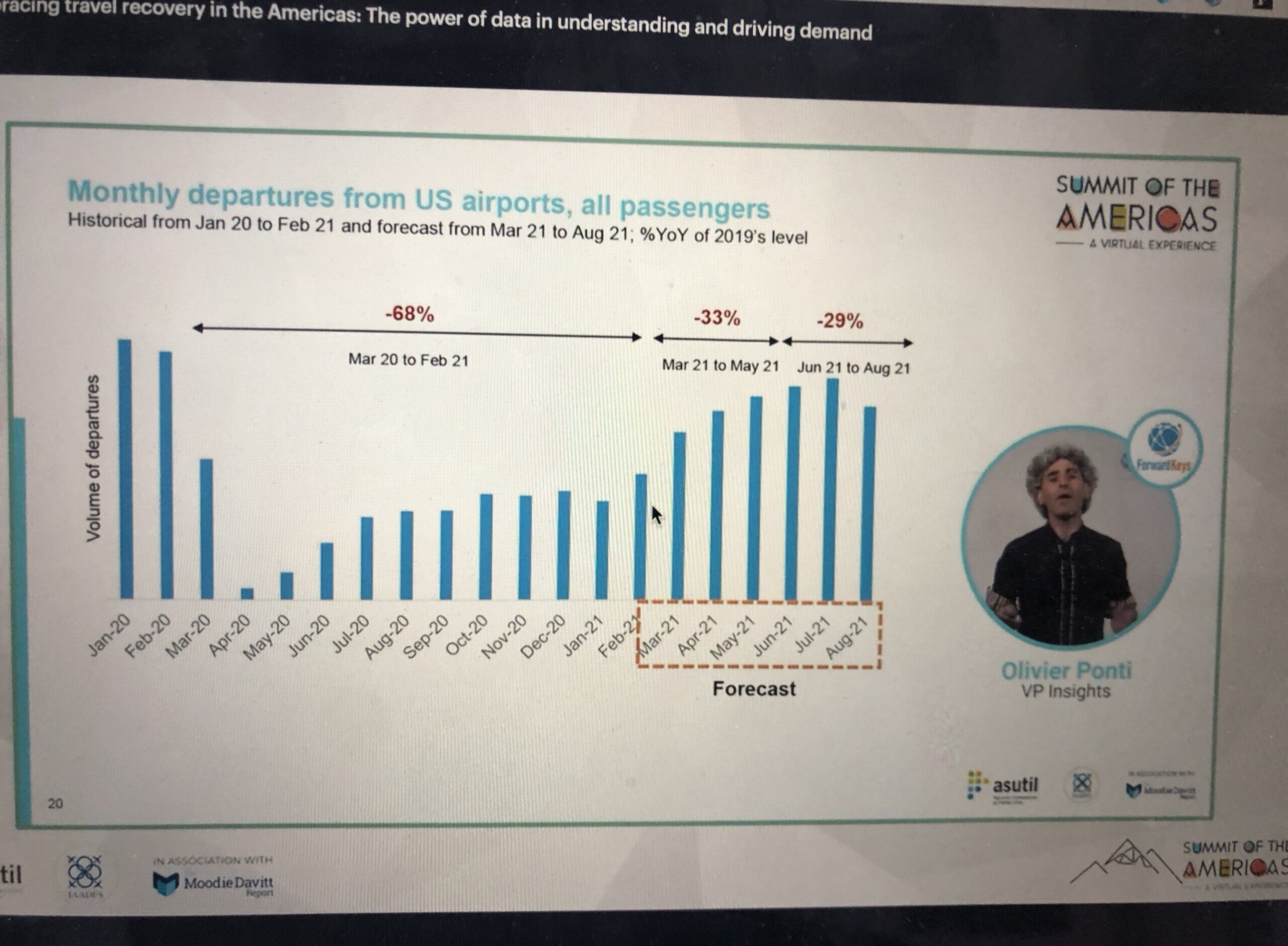
Inter-regional travel has started to reactivate thanks to travel bookings in 2020 that have carried on for Mexico and the Caribbean. Looking at international travel in March – three Mexico tourist spots are among the top 10 destinations for US passengers: Cancun leads the way with 17% of all international destinations, followed by San José del Cabo and Puerta Vallarta.
St Thomas is also strong – bookings are currently 60% ahead of 2019, showing how the US Virgin Islands has been benefitting since last year from easy US connections and open for business status.
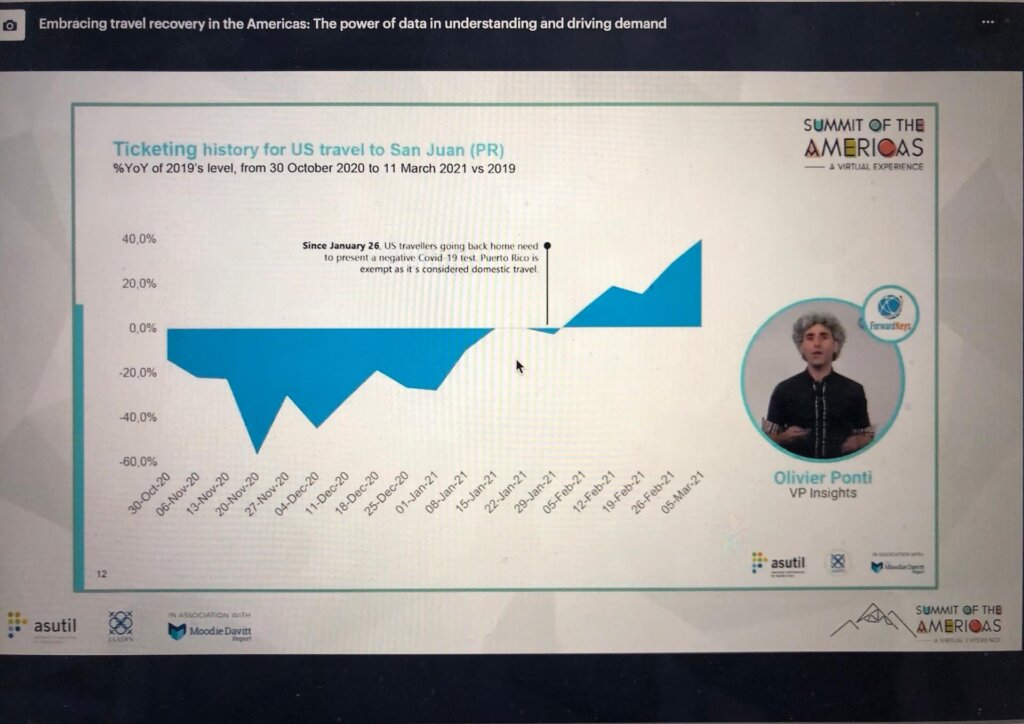
San Juan, Puerto Rico has registered a 10% growth for bookings between March and April and has been growing in popularity since January, because it’s considered a domestic travel destination and visitors do not need to provide a negative Covid test upon return to the US making it one of the most accessible destinations for US travellers.
Middle East – leading a global rebound
The Middle East region is performing slightly better than the world average, with issued tickets 77% behind, against 82% behind worldwide, compared to pre-pandemic travel levels. This is better than in the Asia Pacific and Europe, but not quite as good as in the Americas and Africa, according to the latest insights from ForwardKeys.
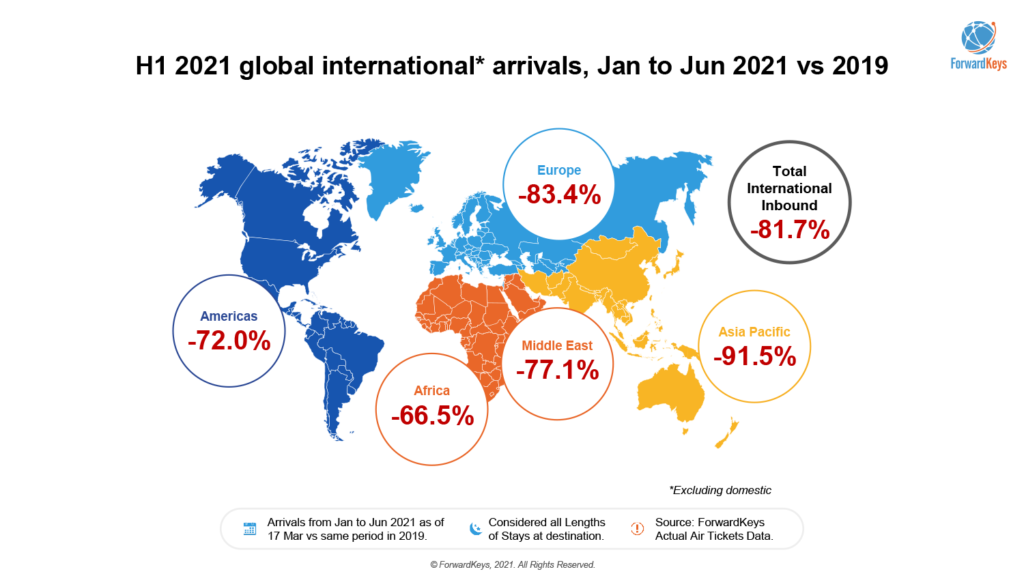
The top five destinations in volumes of tickets in Q1 have been the UAE, Qatar, Saudi Arabia, Egypt, and Bahrain. But when looking at the level of reactivation of travel, we can see that Egypt and Qatar top the list.
“The case of Egypt is really interesting because it illustrates the importance of travel corridors and bilateral cooperation. We can see this very clearly when looking at travel flows from Russia to Egypt,” says ForwardKeys’ Ponti.
Echolution takeout:
Whatever the appetite is for overseas travel this summer, consumers will be subject to more data capture moments, which in turn can help businesses target key demographics more effectively through programmatic campaigns. Where are the digital opportunities for communications or commerce along the passenger journey? There is clear appetite among passengers for digital vaccine passports in the UK, US and Europe and also among airlines that are keen to prioritise digital health security as part of the booking process.
As the travel and tourism industry starts to recover, digital marketing will become key for pre-trip communications, reaching consumers at multiple travel journey touchpoints.




